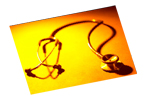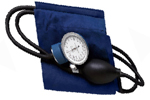Case History
Retraction of a Large Herniated Disc by Non-Envasive Therapy
PATIENT:
A 27 year old, right handed, male with admission complaints of lower back, right buttock and
posterior thigh pain, after feeling “something give” in his lower back while lifting and turning to
stack boxes weighing 50 pounds the previous day.
HISTORY:
He has no known illnesses other than childhood diseases, and denies hypertension, diabetes,
cardiovascular disease, ulcers, stroke, kidney disease, arthritis or hepatitis. He takes no medication,
and does not smoke or drink. He has no allergies. He has had no surgeries. He had two
minor lower back strains in 1982 and 1986, both of which resolved quickly and completely with
conservative care.
EXAMINATION:
The patient is a well developed, symmetrical 5’10”, 150 pound male with normal vital signs.
His posture is antalgic, listing 15 degrees left-anterior, and gait is measured. His paralumbar
musculature is splinted. When seated, upper body weight is supported by arms. Positional
changes are guarded and painful, and unchanged by distraction.
Digital compression at L/S juncture is exquisitely tender and excites paralumbar spasm. Lumbar flexion is limited to 15-20 degrees, extension to 5-7 degrees. Rotation and tilt cannot be performed. Right straight leg raise reproduces back and gluteal pain at 25 degrees. He cannot extend the right leg while seated. Cough and ValSalva maneuver reproduce back and right radicular pain.
Lower extremities are of equal size. Pulses are< 2+ and equal. Deep tendon reflexes, Achilles and patellar, are 2+ and symmetric. No sensory loss is demonstrable.
X-RAY:
Lumbar spine series shows scoliotic defect convexity to right side. L4/5 facettal facings
are asymmetrical. Lordotic curve is reduced in presence of normal pedicular development.
L5/S1 interspace is markedly narrowed without evidence of trophic change. Lumbosacral
facets are moderately imbricated. Foramina are large.
CT-SCAN: (initial)
“Large 9 mm right lateralizing HNP at L5/S1 impacting the dural sac.”
TREATMENT REGIMEN:
Initially, we treated with minimal force manipulation directed at enlarging L5/S1 interspace,
hydrocollator packs and 50 pound intermittent motorized traction daily. He was placed in a soft
support belt. Bed rest was instructed excepting to and from office. He was treated daily for three
weeks, then three times per week for five weeks. As patient improved, traction was increased to
tolerance, eventually reaching 80 pounds.
PROGRESS:
Approximately two months after injury, patient was re-evaluated. His posture was upright
without antalgia, and his gait was fluid and even. Positional changes were accomplished with
ease. Lumbar spine flexes to 45 degrees and extends to 10 degrees without pain. Right lateral
bending does cause mild lumbosacral pain. Bechtherew is accomplished without pain. Straight
leg raises to 80-85 degrees on right.
He was released to light work and treatment regimen reduced to once every 3-4 weeks.
CT-SCAN COMPARATIVE:
Approximately 10 months after onset, a comparative scan was made of the affected L5/S1
disc showing retraction from the original 9mm herniation. Report reads as follows: “There has
been significant improvement in the appearances at L5/S1. The previously postero-central and to
the right of center herniated disc material has largely disappeared. Only a small postero-central
protrusion, superimposed on the diffuse 5-6mm disc bulge is noted. This residual bulge impacts
mildly on the dural sac due to a prominent epidural fat space.”
COMMENTARY:
To our knowledge, this is the first recorded case of herniated disc retraction through non-surgical
methods. The chiropractic principle has been an enigma to the scientific community. Sophisticated
diagnostic instrumentation no longer is outside the domain of the clinical chiropractor. It
now befalls fellow practitioners to gather through frugal utilization of accepted diagnostic procedure,
the hard evidence verifying the efficacy of chiropractic’s role in the health care system.
Think about this!
The ‘case history’ article above was written by Dr. Martin and published by the
Texas Journal of Chiropractic in 1988; over 16 years ago! At that time, it was estimated
Dr. Martin was in the top 5 chiropractic physicians in Texas and likely the top 10 in
the nation. Our constant pursuit of excellence has resulted in unprecedented healthcare
results. A large quantity of providers, both, chiropractic and allopathic, remain
stuck in this 16-year old muskuloskeletal treatment model.
Today the enigma is removed.
We now have the requisite training and clinical experience to diagnose and treat a
very broad range of neuro-muskuloskeletal expressive disorders. Conditions you are
experiencing now. Is the latest medication your taking making you all better now?
Tools of the Trade
 You might notice when you have an appointment we measure and record your blood pressure, pulse
rate, and percent of oxygen saturation; all bilaterally. It is a design of the human system to have opposing
controls of autonomic functions that operate in homeostasis. The best measure for comparison is
left hemisphere against right hemisphere. By definition how can you measure anything without
You might notice when you have an appointment we measure and record your blood pressure, pulse
rate, and percent of oxygen saturation; all bilaterally. It is a design of the human system to have opposing
controls of autonomic functions that operate in homeostasis. The best measure for comparison is
left hemisphere against right hemisphere. By definition how can you measure anything without a baseline for comparison? Bilateral measurements compare the total system function
against the component function. You compared to You. The doctor can discuss what the bilateral
a baseline for comparison? Bilateral measurements compare the total system function
against the component function. You compared to You. The doctor can discuss what the bilateral
 variations indicate. Additionally, the doctors use the opthalmascope to look inside the eye.
They record the vein to artery (VA) ratio presented by your system at that particular moment at examination.
variations indicate. Additionally, the doctors use the opthalmascope to look inside the eye.
They record the vein to artery (VA) ratio presented by your system at that particular moment at examination.
Address
2110 North Center St.,
Suite A
Bonham, TX 75418
phone: 903.583.7574
fax: 903.640.2067
Directions
click to view map
Online Video!
click to view video